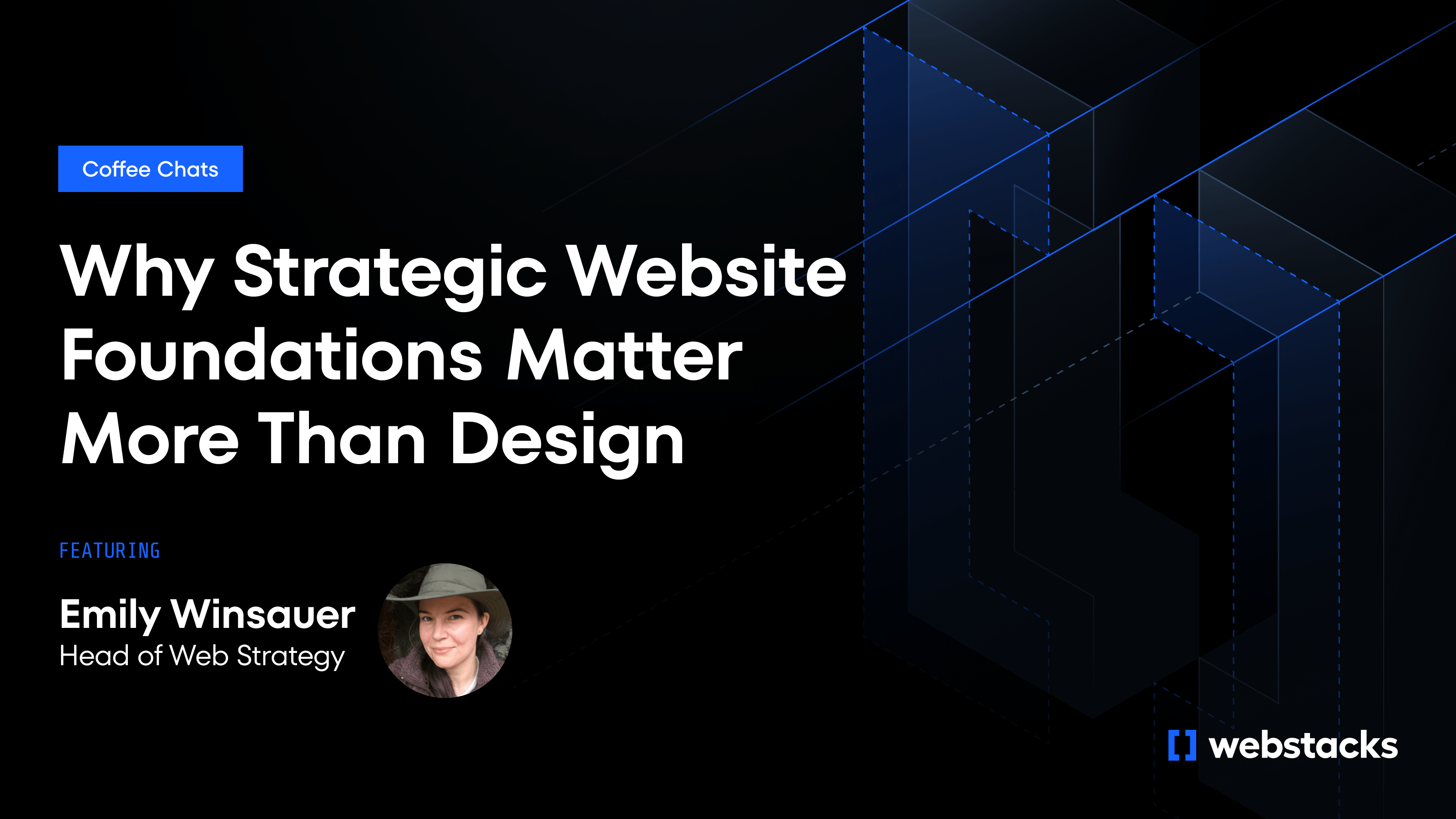Product-market fit fundamentally changes what your website needs to accomplish. Before PMF, your site explained a novel solution to curious early adopters and collected feedback. Now you need a conversion engine that attracts larger market segments, scales operations, and generates a predictable pipeline.
This shift requires a complete strategic overhaul. The website transforms from a marketing asset into core growth infrastructure—the foundation that makes aggressive revenue goals achievable. This framework gives marketing leaders a systematic approach to redesign for scale while maintaining the agility needed for continuous optimization.

1. Content Strategy Transformation
The messaging that convinced early adopters won't resonate with the buying committees you now face. Early adopters bought into potential; post-PMF prospects demand concrete proof of measurable business impact.
Anchor on One Primary Benefit with Segment-Specific Expressions
Start by identifying your strongest competitive differentiator—the one metric or outcome where you consistently outperform alternatives. This becomes your primary value proposition across all touchpoints. Superhuman's "fastest email experience" and Linear's "speed for software teams" demonstrate how focused positioning cuts through market noise.
Your primary benefit then adapts to segment-specific language and proof points. The core differentiator remains constant, but its expression changes based on audience priorities. If your primary benefit is "workflow acceleration," a DevOps manager sees "reduces deployment time by 60%" while a sales director sees "shortens deal cycles by 3 weeks."
Replace Speculative Language with Customer-Driven Metrics
Audit every headline, hero section, and CTA for claims that sound aspirational. Eliminate phrases like "revolutionary," "game-changing," or "unlock potential." Replace them with specific metrics from actual customer results: "reduces manual reporting by 73%" instead of "streamlines workflows."
Source these numbers directly from customer success data, support analytics, and usage metrics. If gaps exist, survey your top-performing customers with targeted questions: Which specific metric improved most after implementation? What quantifiable time savings do you experience weekly? How did key performance indicators change month-over-month?
Deploy Strategic Social Proof
Social proof now carries more weight than feature demonstrations, but placement determines impact. Thread customer logos, satisfaction scores, and usage metrics into high-intent decision zones: adjacent to pricing tables, within demo request flows, and above-the-fold on landing pages.
Use contextual rather than generic proof points. Place ROI-focused customer quotes directly on pricing pages. Display industry-specific logos on corresponding solution pages. Show recent review scores near conversion CTAs. Keep proof current and specific—"4.8/5 stars from 127 reviews this quarter" outperforms "loved by 500+ customers."
Structure Segment-Specific Solution Architecture
Reorganize content around distinct buyer personas rather than feature inventories. Create dedicated solution pages that address specific pain points and desired outcomes for each ideal customer profile. This targeted approach reduces cognitive load while enabling prospect self-qualification.
Each solution page follows a consistent structure: specific problem statement, quantified outcomes from similar customers, and a clear conversion path. This systematic content organization supports your primary value proposition while speaking directly to segment-specific priorities.
2. Technical Foundation for Scale
Your content strategy requires technical infrastructure that won't become a bottleneck. The monolithic system that supported PMF validation now constrains rapid iteration and multi-channel expansion.
Implement Composable, Headless Architecture
Separate content from presentation through a headless CMS approach. Content lives in an API-first system like Contentful or Strapi, while your frontend controls presentation and user experience. This separation enables simultaneous development on multiple channels—web, mobile, partner portals—without content duplication or version control conflicts.
Build with modular, reusable components that reflect your content strategy. Create standardized blocks for hero sections, testimonials, pricing tables, and CTAs that maintain brand consistency while enabling rapid page construction. When pricing changes across multiple pages, you update one component instead of hunting through templates.
Establish a Clear Governance Framework
Assign role-based permissions that align with your team structure and strategic priorities. Content marketers own copy updates within predefined templates. Designers control component libraries and brand standards. Engineers handle new functionality and integration requirements.
This governance model prevents bottlenecks while reducing the risk of unauthorized changes affecting live conversion paths. Document approval workflows, deployment procedures, and rollback protocols before they're needed under pressure.
Execute Phased Migration Strategy
Migrate high-impact pages first: pricing, demo requests, core product pages, and primary landing pages. Test thoroughly in staging environments, monitor performance post-launch, then proceed with long-tail content migration.
Start with one component type—typically blog posts or case studies—perfect the workflow and governance procedures, then expand to complex product pages. This approach maintains site stability while your team adapts to new systems and processes.
The technical foundation you build here directly enables the content personalization discussed in section one while supporting the conversion optimization framework covered next.

3. Conversion System Optimization
Post-PMF traffic volumes expose conversion bottlenecks that forgiving early adopters previously overlooked. Generic CTAs, buried pricing, confusing navigation, and lengthy forms now directly impact revenue as your audience shifts from enthusiastic early users to discerning buyers.
Map and Optimize the Complete Buyer Journey
Document every page a prospect visits from initial awareness to signed contract. Assign one primary measurable goal to each journey stage: homepage drives demo requests, solution pages build confidence, pricing pages qualify budget fit.
Identify and systematically eliminate friction points. Move pricing information to the primary navigation instead of burying it in the footer. Create dedicated demo request flows without sidebar distractions. Build industry-specific landing pages that route visitors to relevant use cases and social proof.
Streamline Form Performance and Progressive Profiling
Forms present the highest-impact conversion optimization opportunity. Reduce initial fields to essential information: name, email, company size, and primary use case. Each removed field typically increases conversion rates by 5-15%.
Implement progressive profiling to gather additional qualification data during subsequent touchpoints when trust is established. Collect basic contact information initially, then request budget range, timeline, and decision-making process details during follow-up interactions.
Optimize Mobile Experience and Cross-Device Performance
Monitor mobile performance as a leading indicator of overall user experience health. Bounce rate spikes on mobile devices often signal layout issues, slow load times, or navigation problems that desktop testing missed.
Test across device breakpoints weekly rather than only at major releases. Mobile traffic continues growing across B2B segments, and mobile experience quality increasingly influences desktop conversion decisions.
Your optimized conversion system generates the data needed for the measurement framework that drives continuous improvement.
4. Measurement and Iteration Framework
Transform your redesigned website into a conversion laboratory where systematic testing and user research guide optimization decisions. This framework ensures your site performance improves consistently rather than plateauing after initial launch gains.
Implement Comprehensive Analytics and Attribution
Tag every component with performance tracking so you understand which testimonial placements drive conversions, which CTAs generate qualified demo requests, and which content paths correlate with closed revenue. Build measurement into your architecture rather than retrofitting analytics later.
Use server-side tracking to maintain attribution accuracy as browser privacy restrictions continue tightening. Document the complete customer journey from first touch to contract signature, enabling marketing attribution that aligns with sales process realities.
Establish Systematic Testing Methodology
Treat testing as ongoing optimization rather than one-time experiments. A/B test headlines, CTA placement, page layouts, and form designs based on conversion data insights rather than opinions or industry best practices.
Prioritize tests based on traffic volume and potential impact. High-traffic, high-stakes pages like pricing and demo requests deserve immediate testing attention. Long-tail content pages can follow established patterns proven through systematic testing.
Conduct Regular User Research and Validation
Schedule monthly user testing sessions with prospects from target segments. Watch them navigate your site, request demos, and complete forms. Five user sessions reveal more conversion barriers than months of analytics review.
Record sessions and document insights for cross-functional sharing. When prospects hunt for pricing information or hesitate at form fields, you've identified immediate optimization priorities. Share these insights with sales teams to align website experience with phone-based prospect feedback.
Monitor Leading Indicators and Business Impact
Track conversion metrics that connect directly to revenue outcomes: demo request quality, sales-qualified lead conversion rates, and average deal sizes from website-sourced prospects. Monitor these leading indicators weekly rather than waiting for quarterly business reviews.
Establish performance baselines before implementing changes, then measure improvement over 30-60 day periods to account for traffic seasonality and campaign variables. This disciplined approach transforms your website from a traffic destination into a predictable pipeline generator.
Execute Your Post-PMF Redesign
After achieving product-market fit, every conversion rate improvement flows directly into revenue growth. Teams that combine focused redesign strategy with systematic optimization often see 20-40% improvements in core metrics like demo requests and sales-qualified lead generation. Your redesigned website becomes a competitive advantage when content strategy, technical architecture, conversion optimization, and measurement systems work together seamlessly.
The framework above provides the strategic roadmap, but execution requires expertise in composable architecture and the technical nuances of scaling marketing websites. Companies like ServiceTitan and Braze have partnered with Webstacks to break free from website bottlenecks and accelerate pipeline generation through composable approaches that enable rapid iteration while maintaining enterprise-grade performance.
Ready to transform your website into your most reliable growth engine? Book a call with our experts.




